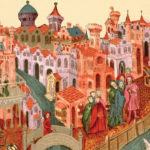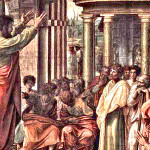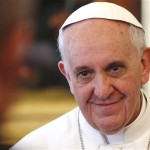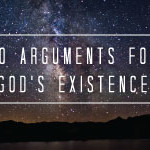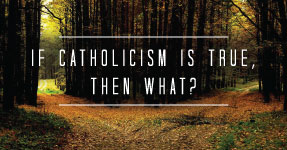Why Miracles are Credible to Catholics
by Dr. Dennis Bonnette
Filed under Uncategorized

Unlike many other articles dealing with miracles, this one is not actually expected to change minds about the reality of such phenomena. Rather, it is intended to show why miracles are believed and should be believed by believers as well as why miracles are not believed and likely will not be believed by unbelievers. The focus here is less on the extraordinary events themselves and more on the reasons why some people believe the reports about them, while others do not.
The extraordinary phenomena at issue include both preternatural and supernatural events. By the term, “preternatural, is meant events that exceed the common order of nature, although given other conditions, such events might be explained naturally. For example, while humans can fly in airplanes, such flight would be beyond their unaided natural powers.
The term, “supernatural,” is reserved for those events that cannot be explained by natural forces under any conditions whatever. They require the infinite power possessed by the God of classical theism alone, for example, causing the resurrection of a truly dead person. Strictly speaking, the term, “miracle,” pertains exclusively to supernatural events.
Preternatural events stand in an intermediate position between the purely natural and those that are supernatural.
I include preternatural phenomena in this essay, since such realities belong to many reports which natural science cannot explain, and hence, would challenge the metaphysical assumptions of many modern materialists. I realize that naturalists would claim to be impressed by genuine miracles alone.
The Reports
Many reports of miracles are dismissed because things like cancer cures can be explained as mere remissions. Yet, the resurrection of Christ is hotly contested as to fact, since it clearly entails a genuine miracle. Remarkably, there exists a book, Saints Who Raise the Dead: True Stories of 400 Resurrection Miracles by Albert J. Hebert, which presents details of many claimed actual resurrections of the dead down through history. Most appear to be found in the biographies of major saints of the Catholic Church.
Yet, how do we know that the “dead” in these alleged resurrections were actually even really dead? In most cases, absolute verification of death before the resurrection takes place could hardly be expected – especially in past centuries, since who would anticipate ahead of time that someone would be resurrected – thereby causing subsequent need to prove actual prior death?
Nonetheless, a rather strong indication of death is reported in a resurrection attributed to St. Vincent Ferrer (1350-1419). A woman became insane, slit her small son’s throat, dismembered his body, and roasted a portion, which she then tried to serve to her husband. St. Vincent prayed over the remains and the reassembled pieces arose as the living boy. This case was part of the saint’s canonization process.1 In many other cases, the deceased was dead for days, hanged by the neck for days, suffered violent deaths, or even sealed in a coffin for long periods.2 Undoubtable death was evident in most cases. Testimony affirming resurrections was recorded by responsible authorities in many cases, such as in a formal canonization process.
An oddly different set of extraordinary events is the reported appearances of dead persons to living ones in the form of souls allegedly coming from Purgatory or, rarely, even from Hell itself. These apparitions were predominantly visible phenomena or even fully physical presences as “living” human beings. Here again we have another work listing literally hundreds of such instances in Purgatory by F.X. Schouppe. Like the book on cases of reported resurrections, these accounts are assembled from many earlier books, records, canonical investigations, historical testimonies, and so forth.
And then, not surprisingly, we have a number of “encounters” recorded between Padre Pio and souls from Purgatory appearing before him, sometimes so physically present that others could see them.
I will add here a rather curious case of private revelation which is of interest both because it is relatively recent and because of the large number of attesting witnesses. The Miraculous Crucifix of Limpias is found in a church in Santander, Spain. During the period around WWI, thousands of eyewitnesses saw Christ’s body on the crucifix “come alive” and show powerful signs of emotion and suffering, including evident breathing and physical motions.
“The multiple albums that are found in the sacristy of the church of Limpias contain well over 8,000 testimonies of people who had seen the wonderful apparitions. Of these, 2,500 were sworn on oath. Among these witnesses were members of religious orders, priests, doctors, lawyers, professors, and governors of universities, officers, merchants, workmen, country folk, unbelievers and even atheists.”
What is the Point?
I am not trying to produce some kind of direct evidence to prove to the readers the truth of all these reports of preternatural or supernatural events described above. Rather, my focus is on the difference in the reaction of believers and non-believers to these reports.
Many believers are not familiar with all these reported “miraculous” events, but on hearing of them, tend to believe, especially when they realize that such reports have recurred often though history. But, why is there such natural sympathy on the part of believers, especially Catholics?
And why do non-believers express instant skepticism by offering various rationales for dismissing the credibility of such reports? Is it merely pure prejudice, as G.K. Chesterton seems to suggest?
“If we say miracles are theoretically possible, they say, “Yes, but there is no evidence for them.” When we take all the records of the human race and say, “Here is your evidence,” they say, “But these people were superstitious, they believed in impossible things.”
In fairness, I suggest that the Catholic mentality about such accounts of religious prodigies is received with greater acceptance for the simple reason that Catholics understand the nature of the Catholic faith. Now, what I just said is easily misunderstood, since I am not saying that belief in these reports is simply a matter of blind faith. On the contrary, there is a rational process going on here – but one that would, doubtless, not sound equally rational to the skeptic, agnostic, atheist, or unbeliever.
For Catholics, the persons offering these reports are seen to be very holy people for the most part -- indeed, saints! As such, it is expected that they will tell the truth. It is essentially as simple as that.
Moreover, all Catholics know that to tell a deliberate lie in a serious matter -- such as falsely claiming a miracle – is a mortal sin and matter for Confession. That hundreds of committed Catholics would tell such lies separately, and yet, en masse is a moral impossibility. While those who are not practicing Catholics may not understand this simple truth, those who are practicing Catholics will easily see that such uncoordinated mass deception over many centuries could never occur.
Oh yes, some will allege that the witnesses affirming these reports might be hallucinating, mentally obsessed or even psychotic, suffering delusions, or otherwise incapacitated from having normal observational objectivity. The difficulty with those sorts of explanations is the great number of such witnesses and the even greater number of such reports. A few cases may be explained in this skeptical fashion, but surely not in such vast numbers. Moreover, the psychological stability of those witnesses later declared as saints have withstood the careful evaluations of the canonization process.
Even a single authentic report of an apparition or miracle is sufficient to establish beyond question an entire order of reality generally rejected out of hand by skeptics. Unfortunately, for the skeptic, his corresponding task is to refute every single report – a task obviously impossible on its face. Even for the more nuanced position of naturalism, a single authentically-supernatural event (miracle) would constitute absolute refutation.
On the other hand, to the skeptic or agnostic, the entire order of such claims is instantly suspect, since they are not first attending to the standard of holiness and/or veracity demanded of the consciences of ordinary Catholics, say nothing of saints! Rather, what impresses their view is the seeming absurdity or impossibility of the claims themselves – claims which, on their very face, seem to demand incredulity.
Paradoxically, the very practice of his own faith enables the believer to see with conviction the essential truthfulness of all this devout witness testimony – something that is inherently obscure or unbelievable to the skeptic. St. Anselm of Canterbury’s insight, which reveals the inherent connection between true faith and rational intelligibility, now becomes clearly evident: Credo ut intelligam. I believe in order that I may understand.
Fatima: God's "Assist" for Skeptics
Almost as if God chose to answer the skeptics who complained that no easily verifiable major public miracles had occurred in modern times, the twentieth century witnessed the most public miracle of all time.
At Fatima, Portugal, on October 13, 1917, God dramatically removed many of the objections to belief that skeptics raise against the sorts of extraordinary phenomena treated earlier in this essay. As if to answer those who doubt events from hundreds of years ago, this massive “miracle of the sun” occurred in the early twentieth century, when modern means of photography, major newspaper coverage, and electronic communication were available – as well as having testimony taken nearly half a century later when many eyewitnesses were still alive.
Rather than an event observed by a single person or relatively few (except in the case of the Limpias Crucifix cited above), this miracle was witnessed by at least forty and, perhaps, as many as one hundred thousand persons. It was not a genuine motion of the sun itself, since that would have been observed by astronomers and drastically shaken the earth as well. It was some sort of massive visual experience that was not identically, and yet was largely similarly, experienced by huge numbers of those present – an experience that defies natural explanation by various skeptical hypotheses.
What many also do not understand is that the fact that all present did not see the exact same thing is, rather than a cause for skepticism, clear proof that it was a massive set of apparitions following the same theme, but with enough variation to show that no common external physical cause could be responsible. Some failed to see anything. Whatever caused this phenomenon was able to create a generally common subjective experience in tens of thousands of persons simultaneously, but also could make variations therein or even fail to cause any experience whatever in some.
Worse yet for skeptics, the event entails three distinct aspects – any of which by itself could be described as a miracle, but all three variables at once are decisive. They were: (1) the prediction of a stupendous miracle ahead of time (so that both believers and skeptics and reporters came by the tens of thousands from all over Portugal), (2) the visual phenomenon itself, and (3) the simultaneous sudden and complete drying of the people and the muddy ground, which had been rain soaked all morning. Some may try to explain one or another aspect, but the three simultaneously-joined, objectively verifiable, psychic, visual, and physical phenomena present an extraordinary event not seen in human memory.
So, the Fatima miracle stands by itself.
"Thank You, Father"
The following incident took place recently in an American diocese whose locale includes cemeteries dating back to the Civil War.
There is a house in the country on the top of a hill well off a main road with a long driveway from the road to the house. A mother and her son living there appear at their local Catholic pastor’s rectory, clearly upset and shaken – reporting certain disturbing “experiences” occurring in that house. These include such things as lights turning on and off by themselves, a child’s hand prints suddenly appearing on a clean metal door, and the father having an unseen force suddenly thrust him face first into a wall so hard that it dents the wall.
Having related these incidents, the mother and son convince their priest to go out to the house and say Mass and bless everything, which he does – first, by saying Mass and blessing the house, and then, by blessing a cemetery behind the house. The father then led the priest down a side trail -- maybe seventy yards -- to the foundations of an old house, where a thirteen year old girl had lived long ago. Three men had raped the poor girl and then hanged her in a tree next to that second house. They then buried her in a shallow grave right by a creek at that location.
And so, the priest also blessed the murdered girl’s grave.
After all this, having taken his leave, the priest is driving down the long driveway from the top of the hill where the main house is located. He reaches the bottom where it joins a country road. His car’s windows are shut with both heater and radio off. All is dead silence.
At this point, the priest hears clearly the voice of a young woman in his left ear, who says to him, “Thank you, Father.”
Since the reader does not know this priest, it is easy to be skeptical of the whole report. That is the reason, I suspect, that most skeptics and agnostics dismiss stories of Catholic and other miracles or preternatural experiences with a grain of salt – especially, since they know such things are impossible (as Chesterton noted).
Personally, I find absolutely credible the facts as related to me directly by the priest involved. This one incident, all by itself, is sufficient reason for me to believe that Catholic priests do have real powers. And this, in turn, tells me all I really need to know about the truth of the Catholic Church.
The reason I am convinced that the events happened exactly as related is because I have been a personal friend of the priest involved for nearly half a century. I know he is a good priest, who takes his obligations to the Faith and to tell the truth dead seriously. I know he is sane, sober, and has never told me of another similar experience. In a word, I am perfectly confident in his competence and veracity for reasons personally known to me -- reasons which the readers of this essay in no way share.
Conclusion
So it is with the general reaction of believers to the extensive reports of Catholic and other Christian miracles and extraordinary events. Believers know the moral rectitude of the vast majority of those in their faith who experience these things, report them to superiors, and the superiors themselves who conduct such serious matters as canonical investigations. Even if one doubted a few such reports in specific instances, the mere fact that hundreds of such extraordinary religious phenomena have been recorded in history constitutes powerful reason for believers to accept the reality of such preternatural and supernatural phenomena.
That is why believers believe in such reported miracles. Perhaps, also, it is this mechanism of “referred eyewitness certitude” that explains the vivid faith of early Christians that Christ truly rose from the dead. Indeed, this finally makes perfect sense of St. Paul’s unique report that the risen Christ “was seen by over five hundred brethren at once” (1 Corinthians 15:6, New King James Version), since such widespread eyewitness foundation would easily have convinced others that the Resurrection was a fact beyond all doubting.
To the contrary, it is the corresponding lack of confidence in devout witnesses and ecclesiastical investigations and historical records which probably causes unbelieving skeptics to dismiss the whole matter with total incredulity, while they spend their time and energy engaging in speculative disputations about the historicity of Scripture and the existence and coherence of the God of classical theism.
This is also probably why each side, from its own perspective, is so thoroughly convinced that the other side is dead wrong.
Related Posts
Note: Our goal is to cultivate serious and respectful dialogue. While it's OK to disagree—even encouraged!—any snarky, offensive, or off-topic comments will be deleted. Before commenting please read the Commenting Rules and Tips. If you're having trouble commenting, read the Commenting Instructions.





